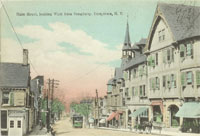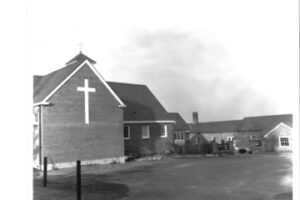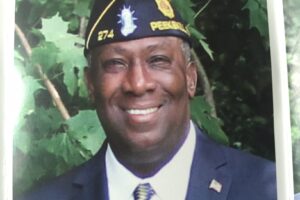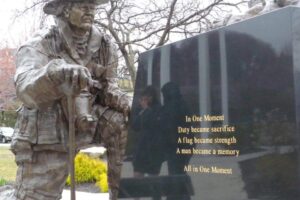
Situated on the eastern shore of the Hudson River, in an area called the Tappan Zee (Tappan for the Tappan Indians who once lived in what is now Rockland County, and Zee meaning sea in the Dutch language), lies the village of Tarrytown, a village rich in history and, of course, local legend.
It is a village of rolling hills, twenty-five miles north of New York City.
The first residents of what eventually became Tarrytown were the Weckquaesgeeks Indians. The Weckquasgeeks were a friendly tribe that were closely related to the Wappinger Confederacy and further related to the Mohicans. They raised corn, squash, beans and tobacco. They fished the Hudson for shad, oysters and other shellfish. They hunted the area for deer and black bear. They also trapped for fur and hides for clothing and later traded these with the Dutch. Their principal settlement was at the foot of Church Street at the place they called Alipconk, or the Place of Elms.
Records show that the first residence in Tarrytown was built in 1645; however, the exact location is not known. The first white settlers were Dutch and they were farmers, fur trappers and fishermen. Tarrytown soil was light and loamy which was ideal for growing cereals, especially wheat. This led to the area being known as Wheat Town, or Terve Town, which later became mispronounced as Tarrytown. However, I prefer Washington Irving’s interpretation of the origin of Tarrytown’s name in The Legend Of Sleepy Hollow which was published in the Sketch Book in 1820. Irving began his story, “In the bosom of one of those spacious coves which indent the eastern shore of the Hudson, at that broad expansion of the river denominated by the ancient Dutch navigators of the Tappan Zee, and where they always prudently shortened sail and implored the protection of St. Nicholas when they crossed, there lies a small market town or rural port which by some is called Greenburgh, but which is more generally and properly known by the name of Tarry Town. This name was given, we are told, in former days, by the good housewives of the adjacent county, from the inveterate propensity of their husbands to linger about the village tavern on market days.” Washington Irving has had the distinction of being the first American writer who was recognized by the British and European community. There have been countless references and movies made about his famous story. Our local high school is named Sleepy Hollow High School and our local team is named the Horsemen.
A great deal of our history began when Frederick Philipse, a wealthy businessman, began buying land in 1681 and became the largest land-owner in the Tarrytown area. He controlled 22 miles of land from the Croton River south to Spuyten Duyvil, and from the Hudson east to the Bronx River. He acquired 90,000 acres and built his main home and gristmill in our sister town of Sleepy Hollow. This was his main distribution center for grain on the Hudson. Frederick Philipse was also responsible for building The Old Dutch Church of Sleepy Hollow in 1697. When Frederick died in 1702, his son Adolph became “Lord of the Manor.” He doubled the size of the original home and increased the capacity of the mill by adding a third set of millstones so that he could grind barley and corn as well as his wheat. The main home and gristmill have been restored to appear as they did in the mid-18th century and is currently a historic restoration that may be visited under the auspices of Historic Hudson Valley. Throughout the 18th century, most of life continued to revolve around the mill.
One very important event occurred in Tarrytown during the Revolutionary War. On September 23, 1780, three local militiamen, John Paulding, Isaac Van Wart and David Williams, captured the British spy, Major John Andre. Major Andre was carrying papers describing the fortification of West Point, given to him by Benedict Arnold. The clandestine meeting near Haverstraw ended at dawn making it too risky for the Loyalists to row Andre back to the Vulture, which was to carry him back to British Headquarters in New York City. The next day the Americans fired upon the Vulture from Croton Point, forcing it to leave without Andre. There is a historical marker at the foot of Church Street because Americans again fired on the Vulture as it passed Tarrytown. Benedict Arnold recommended that Andre travel by land on the east side of the Hudson and was traveling south on horseback, eventually reaching the neutral territory of Tarrytown.
John Paulding, who had recently escaped from a British prison in New York City, was wearing a Hessian coat and Andre approached the group thinking they were allies. He was stopped and questioned by the three militiamen who found the plans to West Point hidden in Andre’s boot. Andre was brought to the authorities. He was tried and convicted as a spy because he had traveled in civilian clothes instead of British uniform. He was hanged in Tappan, New York on October 2, 1780.
A monument was erected near Patriot’s Park on Broadway in 1853 followed by a large parade and dedication. There was another ceremony in 1883, the 100th anniversary. The height of the monument was increased and a bronze statue of John Paulding was added. There is a dedication in stone on the south side of the monument. It reads, “On this spot the 23rd day of September, 1780, the spy, Major John Andre, Adjutant General of the British Army, was captured by John Paulding, David Williams and Isaac Van Wart, all natives of this county. History has told the rest. The people of Westchester County have erected this Monument, as well to commemorate a great Event, as to testify their high estimation of that Integrity and Patriotism which, rejecting every temptation, rescued the United States from most imminent peril by baffling the arts of a Spy and the plots of a Traitor—Dedicated October 7, 1853.” On the north side of the block, an inscription reads, “Their conduct merits our warmest esteem. They have prevented, in all probability, our suffering one of the severest strokes that could have been meditated against us” — Washington.
End of Part One
Richard Miller is the
Village Historian of Tarrytown






